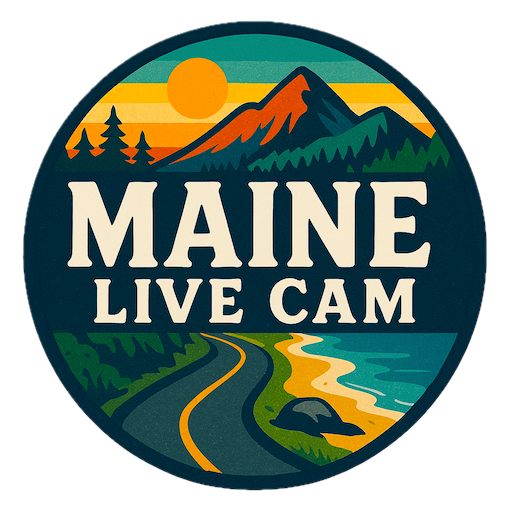Swans Island, Maine Weather Cams
Burnt Coat Harbor Light Cam (View of Burnt Coat Harbor looking towards Minturn)
Burnt Coat Harbor Light Cam (View of the Western Way Entrance to the Harbor)
Burnt Coat Harbor Light Cam (View of the Gulf of Maine looking towards Heron Island)
The Storied Legacy of Swan’s Island & Burnt Coat Harbor Light
Swans Island, Maine Weather Cams. Swan’s Island, nestled six miles off Maine’s rugged Hancock County coast, and its sentinel, the Burnt Coat Harbor Light, share intertwined histories marked by maritime enterprise, community spirit, decline, and renewal.
🌅 Swan’s Island: From Indigenous Ground to Island Community
Early History & Indigenous Presence
First charted in 1606 by Samuel de Champlain, Swan’s Island had been seasonally utilized long before European arrival by Indigenous communities, evidenced by shell middens and coastal artifacts (en.wikipedia.org).
Colonial Acquisition & Settlement
Colonel James Swan—a Boston Tea Party patriot from Scotland—purchased the island in 1786, giving it its name (en.wikipedia.org). The first permanent European settler arrived in 1791. By 1870, the island population reached approximately 570; it incorporated as a town in 1896 (si.mainememory.net).
Economic Transformation
-
Fishing & Shipbuilding: Rich mackerel stocks and sheltered harbors spurred schooner fishing and boat building.
-
Quarrying & Canning: In 1890, quarries opened in Minturn; sardine and lobster canneries followed in the 1890s, as mackerel receded (si.mainememory.net).
-
Community Life: The island’s villages—Atlantic, Minturn, Harbor, North—formed close-knit micro-communities, each with their own stores, schools, halls, and religious institutions. Fraternal organizations added to the cultural fabric (si.mainememory.net).
Decline & Transition
By the 1930s, the Great Depression, WWII labor shifts, and dwindling fish stocks led to diminished industries. Quarrying and canning phased out; the last steamboat was commandeered in 1941 .
Modern Island Life
Today, Swan’s Island hosts a year-round population of around 355 (summer peaking near 1,000) (en.wikipedia.org). Lobstering dominates local fisheries, supported by tourism attractions like the Sweet Chariot Music Festival. The Swan’s Island Historical Society preserves artifacts and oral histories of island life (en.wikipedia.org).
🗼 Burnt Coat Harbor Light: Beacon of Refuge on Hockamock Head
Origins & Construction
As commerce and fishing intensified in Burnt Coat Harbor, the U.S. Lighthouse Board recognized the growing need for navigational safety. A petition in 1857 prompted funding, but it wasn’t until 1872 that plans were approved (islandinstitute.org). The light station—built by the U.S. Army Corps of Engineers—consisted of a square brick tower (32 ft), keeper’s house, oil house (1895), and fog bell house (1911) (en.wikipedia.org).
Operational Era & Keepers
First lit on August 15, 1872, it served as a lifesaving beacon for deep-draft vessels entering the harbor—a refuge known to island captains and schooners alike (islandinstitute.org). Notably, lighthouse keeper Orrin L. Milan served an esteemed 35-year tenure from 1897 to 1932, reflecting the lighthouse’s central role in island life (burntcoatharborlight.org).
Automaton & Decline
The station transitioned to automation in 1975, and the Coast Guard relinquished ownership in 1993. The light remains active, but the keeper’s house began falling into disrepair until community intervention —– (en.wikipedia.org).
Preservation & Restoration
In 1994, the property was transferred to the Town of Swan’s Island, catalyzing a fifteen-year, $900,000 restoration by the town and Friends of Swan’s Island Lighthouse (FOSIL) (islandinstitute.org). This effort carefully preserved historic integrity—retaining original materials, cottages, and structural design—resulting in award-winning revitalization .
Today’s Light Station
-
Visitor Access: The keeper’s house hosts a seasonal museum and art gallery; tours and tower climbs are offered in summer (en.wikipedia.org).
-
Heritage & Rentals: The keeper’s quarters operate as a vacation rental, offering immersive stays in maritime history.
-
Designation: In 1988, the light station was added to the National Register of Historic Places (en.wikipedia.org).
🕰️ Echoes of History: Interconnection & Legacy
Shared Maritime Roots
Both island and lighthouse histories are rooted in Penobscot Bay’s marine lifeblood. The lighthouse rose directly from Swan’s Island’s maritime economy and risks. The residents—fishermen, quarry workers, sea captains—depended on this beacon for safety and livelihood (burntcoatharborlight.org).
Community Resilience
From the 19th century’s boom era to mid-20th century struggles, Swan’s Islanders rallied, later championing landmark preservation. The islands’ transformation—from abandoned harbor to treasured heritage site—speaks to collective tenacity .
Heritage & Continuity
-
Living History: The Historical Society and FOSIL sustain physical spaces and storytelling—a lighthouse climb and museum tell islander tales.
-
Sustainable Use: The keeper’s house doubles as a vacation rental, ensuring upkeep through mindful stewardship.
-
Cultural Vibrancy: Annual events like Sweet Chariot and lighthouse celebrations sustain community bonds and draw visitors.
🔗 Explore Further
-
Swan’s Island Town Website: Extensive resources and ferry info (en.wikipedia.org)
-
Historical Society: Repository of island heritage
-
Burnt Coat Harbor Light Official Site: Visitor schedules, webcams, historical context (en.wikipedia.org)
-
New England Lighthouses’ History: Lighthouse construction and role in maritime safety
-
Maine Preservation Honor Awards: Details on restoration craftsmanship (mainepreservation.org)
🌟 Conclusion
The saga of Swan’s Island and the Burnt Coat Harbor Light mirrors Maine’s maritime heritage: born of wilderness, shaped by industry, tested by decline, and revitalized through community effort. Today, standing lighthouses, preserved houses, and vibrant island life testify to the resilience of coastal cultures—an enduring legacy of light, labor, and local love.
This history is backed by official records, historical society archives, and preservation institutes, ensuring accuracy and honoring the island’s storied past.
Looking for more Maine beach webcams? See our A-Z list for more cams!
